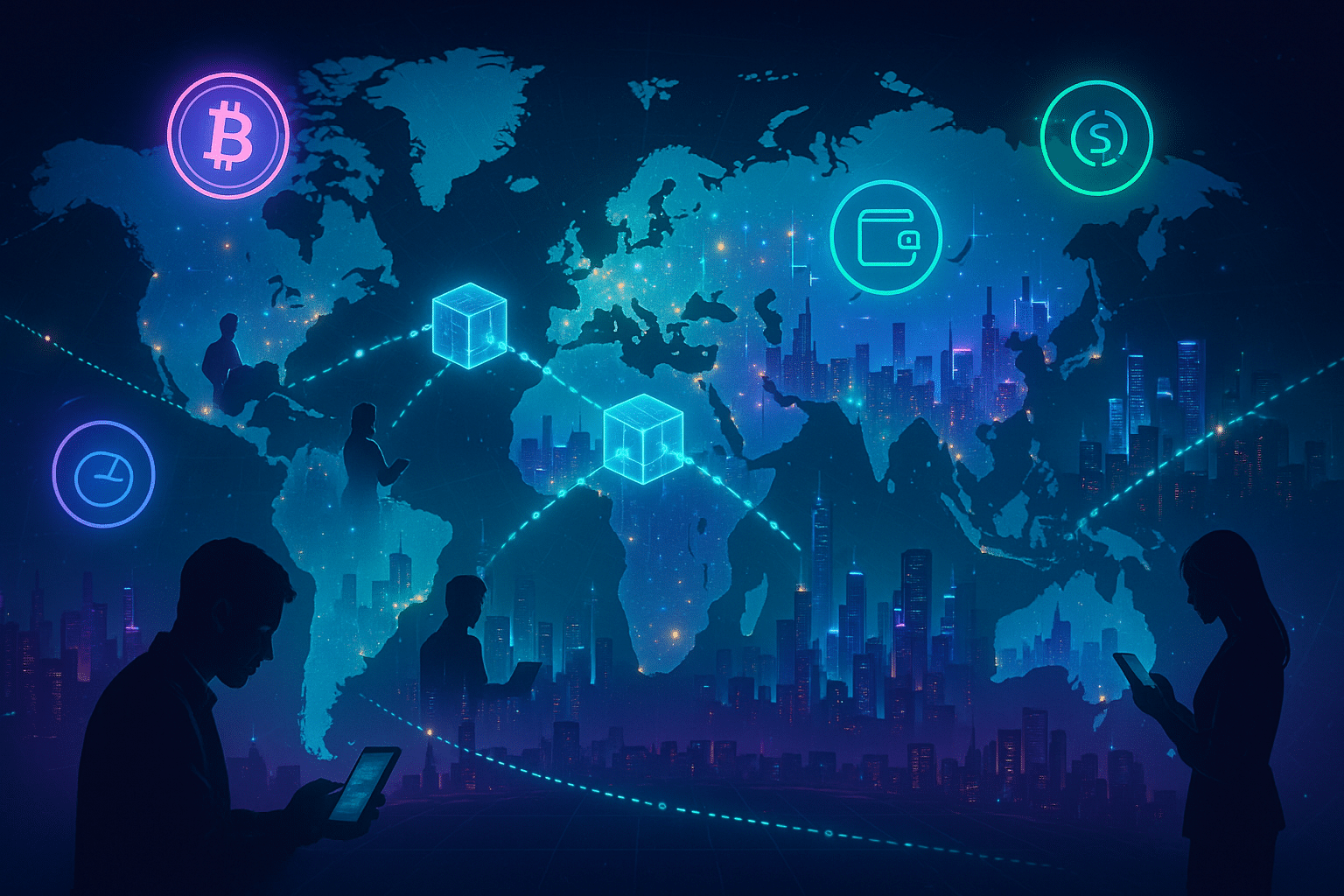Picture this: you’re a small business owner in Brazil wanting to buy high-quality fabrics from a supplier in India. You’re eager to get your hands on the goods but dreading the lengthy, complicated, and costly process of cross-border payments. 🏦💼💸 Then you discover that blockchain technology offers an innovative solution that can revolutionize this aspect of global commerce. 🌐💻🔗
This is no longer a futuristic dream, but a rapidly developing reality. Blockchain technology, often associated with cryptocurrencies like Bitcoin, is poised to dramatically reshape the way cross-border payments are made, unleashing potential for faster, cheaper, and more transparent transactions.
So, why does it matter? 🤔 Well, as our world becomes increasingly interconnected, the ability to move money efficiently across borders is critical. However, the current system is fraught with challenges – it’s slow, expensive, and opaque. In the globalized marketplace of the future, these pain points are simply unacceptable.
But, don’t worry! If you’re feeling a bit confused about what blockchain is or how it can transform cross-border payments, you’re not alone. 🧐 In this comprehensive article, we’ll delve into the world of blockchain, its potential impact on cross-border payments, and why it matters for global commerce.
Getting to Grips with Blockchain
We’ll start by demystifying blockchain technology. Despite its complexity, we’ll break it down into bite-sized pieces so that even those with no prior knowledge can understand its power. We’ll discuss its origins, how it works, and why it’s considered secure and transparent. This understanding will provide a solid foundation for grasping how it can revolutionize cross-border payments. 🧩🔍🎓
The Status Quo of Cross-Border Payments
Next, we’ll take a close look at the current state of cross-border payments. We’ll examine the traditional financial system and its limitations, which have prompted the search for better solutions. Expect an honest discussion about the pain points businesses experience when dealing with cross-border transactions, like delays, high fees, and lack of transparency. 🏦🕰💵
Blockchain to the Rescue
Then comes the exciting part: understanding how blockchain technology can come to the rescue. 🚀 We’ll explore how it can facilitate cross-border payments by offering solutions to the challenges posed by the traditional system. From its potential to dramatically reduce transaction times and costs, to its ability to increase transparency, we’ll delve into all the ways blockchain could revolutionize global commerce.
What’s Next for Blockchain and Cross-Border Payments
Finally, we’ll gaze into the future. 🕵️♂️💭 What opportunities and challenges lie ahead as we move towards adopting blockchain technology for cross-border payments? We’ll discuss recent trends, potential roadblocks, and the steps needed to ensure this technology can fulfill its potential in revolutionizing global commerce.
Ready to embark on this journey of discovery with me? Let’s dive in and explore how blockchain technology is primed to transform cross-border payments, paving the way for a more efficient and transparent global commerce. 🚀🌐🔮
Introduction to Cross-Border Payments and Blockchain Technology
When we take a look at the global commerce landscape, we see an intricate network of transactions that transcend geographical boundaries. Cross-border payments are an integral part of this system, playing a critical role in international trade and commerce. However, these transactions are often riddled with inefficiencies, such as high costs, slow speeds, and lack of transparency. This is where the potential of blockchain technology comes into play.
With its decentralized nature, blockchain technology promises to revolutionize the cross-border payments sector by eliminating intermediaries, reducing transaction times and costs, and enhancing security and transparency. This article will delve deeper into the current challenges in the cross-border payments landscape and how blockchain technology can unlock a new future for global commerce.
For a visual demonstration of blockchain technology and its applications in cross-border payments, consider watching this informative video by World Economic Forum titled “How blockchain will revolutionize cross-border payments?”
Challenges in Current Cross-Border Payments Systems
The existing cross-border payment systems are often complex and time-consuming. They involve multiple intermediaries, each adding their own fees and processing time. The overall lack of transparency makes it difficult for the sender and the receiver to track the payment progress, causing uncertainty and mistrust. Moreover, exchange rate fluctuations can result in loss of value for the money being transferred.
Another challenge in the current system is the lack of inclusivity. According to the World Bank, around 1.7 billion adults globally are unbanked, which means they do not have access to a bank account or any financial services. These people are unable to participate in global commerce due to the lack of access to cross-border payment systems.
A World Bank report from 2018 revealed that the global average cost of sending remittances (money sent back home by migrant workers) is around 7%, far above the United Nations’ Sustainable Development Goal target of 3%. This indicates that the current system is not only inefficient but also expensive.
The Role of Blockchain Technology in Transforming Cross-Border Payments
Blockchain technology has the potential to overcome these challenges and transform the cross-border payments landscape. It operates on a decentralized ledger that records all transactions across multiple computers. This eliminates the need for a central authority or intermediary, thus reducing costs and transaction times.
Moreover, blockchain transactions are transparent and traceable, allowing for real-time tracking of payments. The use of smart contracts, which are self-executing contracts with the terms directly written into code, further enhances the transparency and security of transactions.
Another advantage of blockchain is its potential to promote financial inclusivity. Blockchain-based payment systems can be accessed using a smartphone and an internet connection, making them accessible to unbanked populations. This could revolutionize the remittance industry by making it cheaper and more efficient for migrant workers to send money back home.
Comparing Traditional and Blockchain-based Cross-Border Payments
| Traditional Cross-Border Payments | Blockchain-based Cross-Border Payments | |
|---|---|---|
| Transaction Speed | Slow (up to several days) | Fast (within minutes) |
| Costs | High (due to multiple intermediaries) | Low (no intermediaries) |
| Transparency | Low (hard to track payment progress) | High (real-time tracking) |
| Accessibility | Limited (requires a bank account) | High (accessible to unbanked populations) |
As evident from the table above, blockchain technology holds significant advantages over traditional cross-border payment systems. However, it’s essential to note that the implementation of blockchain in this sector is still in its nascent stages, and there are challenges to overcome, including regulatory uncertainties and technological complexities.
Examples of Blockchain Use in Cross-Border Payments
A number of companies have started leveraging blockchain technology to enhance their cross-border payment solutions. For instance, Ripple, a leading player in this space, uses its blockchain-based technology, RippleNet, to enable fast, low-cost international transactions.
Another example is Circle, a fintech firm, which launched a blockchain-based app, Circle Pay, that allows users to send money across borders without any fees. IBM has also entered this space with its Blockchain World Wire, which uses blockchain and stable coins (cryptocurrencies designed to minimize volatility) to enable real-time global payments.
These examples represent just the tip of the iceberg. As the technology matures and adoption increases, we can expect to see more innovative blockchain-based solutions in the cross-border payments sector.
Conclusion: A New Era of Global Commerce
Blockchain technology has the potential to revolutionize the cross-border payments sector, paving the way for a new era of global commerce. By eliminating intermediaries, reducing transaction times and costs, and enhancing transparency and security, blockchain can overcome the limitations of current systems and unlock immense benefits for businesses and consumers alike.
However, the road to full-scale adoption of blockchain in this sector is not without challenges. These include regulatory uncertainties, technological complexities, and the need for widespread acceptance. As we navigate these challenges and push the boundaries of what’s possible, the future of cross-border payments and global commerce looks bright with blockchain.

Conclusion
In conclusion, we have traversed the digital landscape of Information Technology (IT) and engineering, exploring various concepts and methodologies. We have discovered the transformative nature of these fields, their relevance in the contemporary world, and their potential to shape our future. 🚀
From the intricacies of software development, cyber security, artificial intelligence, to the multifaceted applications of data analytics and cloud computing, we have unraveled the depth and breadth of these disciplines. We have seen how software engineering is evolving, becoming more efficient and effective through agile methodologies and DevOps practices. 🔐💻
In terms of cyber security, we have highlighted the importance of safeguarding data and systems in an increasingly digitalized world, emphasizing the necessity for robust encryption methods, secure networks, and informed users. We have also touched on the revolutionary impact of artificial intelligence in automating processes, enhancing decision-making, and powering innovation. 🤖🧠
We have also ventured into the world of data analytics and cloud computing, exploring their pivotal role in driving business intelligence, operational efficiency, and competitive advantage. We have discussed how data analytics transforms raw data into meaningful insights, and how cloud computing provides scalable, flexible, and cost-effective solutions. ☁️📊
Throughout this journey, we have underscored the need for continuous learning and adaptation in this dynamic field. The pace of technological advancement is relentless, and staying relevant requires an unwavering commitment to knowledge acquisition and skill development. 💡📘
This exploration of IT and engineering would be incomplete without acknowledging their potential in addressing global challenges. From climate change, healthcare, education, to poverty reduction, these disciplines offer solutions that can shape a sustainable and inclusive future. 🌍💫
Finally, this article is not just an exploration of IT and engineering, but also a call to action. It is an invitation for you to delve deeper into these fields, to challenge yourself, to expand your horizons, and to make a difference. Whether you are a student, a professional, or a lifelong learner, there is something in this field for you. 🎯🔬
So, what’s next? I encourage you to comment, share, and apply what you’ve learned. Engage in conversations, collaborate with others, and contribute to the collective knowledge base. Remember, knowledge is power, but sharing knowledge is empowering. 💪🌟
To assist you in your journey, here are some resources to get you started:
1. [Software Engineering](https://www.w3schools.com/software_engineering/)
2. [Cyber Security](https://www.cybrary.it/course/intro-to-cyber-security/)
3. [Artificial Intelligence](https://www.coursera.org/learn/introduction-to-ai)
4. [Data Analytics](https://www.kaggle.com/learn/data-visualization)
5. [Cloud Computing](https://aws.amazon.com/training/learning-paths/)
Here’s to your journey in the fascinating world of IT and engineering! Happy learning! 🎉🚀
Note: All the external links provided are active as of the time of writing this article.
Tags: #SoftwareEngineering, #CyberSecurity, #ArtificialIntelligence, #DataAnalytics, #CloudComputing



